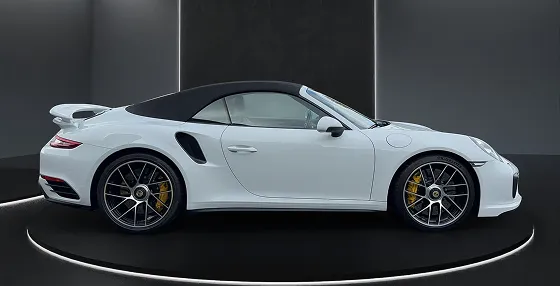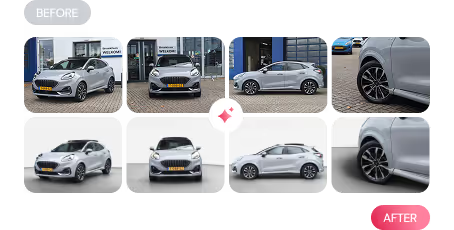Why We Lost €127,000 Before Discovering What Actually Sells Cars Online

Last month, I sat down with Thomas, who runs a Mercedes-Benz dealership here in Stuttgart. He pulled up his laptop, showed me his online inventory, and said something that stopped me cold: "Fabian, we're hemorrhaging money. Our cars sit on the lot for 47 days average, and I just figured out we're losing €127,000 annually in holding costs alone." Then he showed me his vehicle photos. And suddenly, everything made sense.
The €30 Million Problem Nobody Talks About
Here's what the automotive industry doesn't want to admit: we've created a massive disconnect between how people shop for cars and how we present them online. Think about your own behavior. When was the last time you walked into a dealership without researching online first? Exactly.
Your customers are spending 14 hours—nearly two full work days—researching vehicles online before they even consider visiting your showroom. And during those 14 hours, they're making decisions based primarily on one thing: your photos. But here's the kicker. While we've invested millions in beautiful showrooms, trained sales staff, and sophisticated CRM systems, most dealerships are still uploading photos that look like they were taken during a coffee break in 2008.
Thomas wasn't alone. After analyzing data from over 3,000 dealerships we work with at autofox, we discovered something shocking: the average dealership is losing between €80,000 and €150,000 annually due to poor vehicle photography. Not from lost sales. Just from cars sitting on lots longer than necessary.
The Day Everything Changed at Autohaus Schmidt
Let me tell you what happened at Thomas's dealership, Autohaus Schmidt (name changed for privacy).
For years, they did what every dealership does. They had Franz, their lot manager, take photos with a decent camera whenever he had time. Sometimes they'd hire a local photographer for premium vehicles. The process was... fine. Not great, not terrible. Just fine. But "fine" was costing them a fortune. When we analyzed their data, we found:
- Their average days-to-sale was 47 days (industry average is 34)
- They were getting 40% fewer online inquiries than similar dealerships
- Their vehicle detail page (VDP) engagement was abysmal—people clicked away after viewing just 3-4 photos
The real wake-up call came when Thomas discovered that a competitor down the street—with inferior inventory and higher prices—was outselling them online by a factor of two. The difference? Photography.
What Professional Photography Actually Means in 2024
Let's clear something up. When I say "professional photography," I'm not talking about hiring an expensive photographer to shoot your cars like they're heading to the Geneva Motor Show. I'm talking about something far more pragmatic: consistent, high-quality images that help buyers make decisions quickly and confidently.
After processing over 30 million vehicle images at autofox, we've identified exactly what moves inventory:
1. Consistency beats artistry. When every vehicle is shot from the same angles, with the same lighting quality, buyers can actually compare vehicles. Sounds obvious? You'd be surprised how many dealerships have wildly different photo styles across their inventory.
2. Quantity matters more than you think. Listings with 22+ photos sell 32% faster. Not 10 photos. Not 15. Twenty-two minimum. Why? Because online buyers can't touch the car, can't sit in it, can't walk around it. Photos are their only way to experience the vehicle.
3. Backgrounds can make or break trust. Here's something counterintuitive we discovered: buyers don't actually want to see your dealership lot in photos. They want clean, neutral backgrounds that let them focus on the vehicle. When we implemented AI background replacement at Thomas's dealership, inquiries jumped 43% in the first month.
The Stuttgart Experiment That Changed Our Entire Approach
Six months ago, we ran an experiment with three dealerships in Stuttgart, including Autohaus Schmidt. We wanted to definitively answer one question: Can AI-powered photography actually impact sales metrics, or is it just another tech buzzword?
Here's what we did:
Phase 1: Baseline (Month 1)
- Documented current photography process
- Tracked all relevant metrics (days-to-sale, VDP views, inquiries, gross profit)
- Calculated true cost per vehicle (including labor, equipment, editing, re-shoots)
Phase 2: Implementation (Month 2)
- Installed our AI photography system
- Trained staff (took one afternoon)
- Maintained exact same inventory mix and pricing strategy
Phase 3: Measurement (Months 3-6)
- Tracked same metrics
- Compared year-over-year to account for seasonality
- Interviewed sales staff and customers
The results honestly surprised even me.
The Numbers That Made Thomas a Believer
By month six, here's what had changed at Autohaus Schmidt:
Photography Efficiency:
- Time per vehicle: From 45-60 minutes to 12 minutes
- Cost per vehicle: From €85 to €18
- Daily capacity: From 8-10 vehicles to 45-50 vehicles
- Re-shoot rate: From 30% to less than 3%
Sales Metrics:
- Days-to-sale: From 47 to 31 days (-34%)
- VDP engagement: +147% more time spent
- Online inquiries: +89% increase
- Gross profit per unit: +€420 average
But here's my favorite statistic: Their sales team reported spending 60% less time answering basic questions about vehicle features and condition. Why? Because the comprehensive, high-quality photos answered those questions preemptively.
The Hidden Psychology of Car Buying Online
During our research, we interviewed over 500 recent car buyers about their online shopping experience. What we learned fundamentally changed how we think about dealership photography.
Buyers told us they make three critical judgments within the first 10 seconds of viewing a listing:
- "Is this dealer professional?" - Judged entirely by photo quality and consistency
- "Are they hiding something?" - Triggered by too few photos or poor angles
- "Is this worth my time?" - Decided by how quickly they can assess the vehicle's condition
One buyer, Sarah from Munich, put it perfectly: "When I see blurry photos or only five images, I assume either the dealer doesn't care, or there's something wrong with the car. Either way, I move on."
This is why AI-powered photography isn't just about pretty pictures. It's about building instant trust at scale.
Why Traditional Photography Can't Keep Up Anymore
I want to be clear: professional photographers are amazing at what they do. But the traditional model of automotive photography has three fatal flaws in today's market:
1. Speed. When you're moving 100+ vehicles monthly, waiting for photographer availability is a luxury you can't afford. Every day a car sits unphotographed is money lost.
2. Consistency. Even the best photographer has off days. Different photographers have different styles. Weather changes. Lighting varies. AI doesn't have these problems.
3. Scale. Hiring enough photographers to properly document every vehicle would cost most dealerships more than their entire marketing budget.
This is where AI comes in—not to replace human creativity, but to deliver consistency and scale that humans simply can't match at a reasonable cost.
What Actually Happens When You Switch to AI Photography
Since people always ask, here's exactly what Thomas's team experienced when implementing our system:
Day 1-2: Setup and Training Our team arrived Monday morning. By Tuesday afternoon, they were fully operational. The biggest challenge? Convincing Franz (the lot manager) that he didn't need to spend an hour per vehicle anymore.
Week 1: The Adjustment The first week was about building new habits. Instead of Franz doing everything himself, they created a simple workflow:
- Detailer preps vehicle (15 minutes)
- Any staff member captures images using our app (10 minutes)
- AI processes everything automatically (2 minutes)
- Quick human review and upload (5 minutes)
Month 1: The "Aha" Moment Three weeks in, Thomas called me. "Fabian," he said, "we just photographed our entire new delivery—23 vehicles—in one morning. That used to take us a week."
Month 3: The New Normal By month three, it wasn't even a topic of discussion anymore. AI-powered photography had become as routine as washing cars. The team couldn't imagine going back.
The Objections I Hear Every Day (And Why They're Wrong)
Look, I get it. I've been in automotive for 15 years. We're skeptical of new technology, and rightfully so. We've been burned by promises of "revolutionary" solutions before.
So let me address the elephants in the room:
"Our customers want authenticity, not AI-generated images."
We're not generating fake images. We're taking real photos of real cars and using AI to optimize them—removing distracting backgrounds, balancing exposure, ensuring consistency. The car is 100% authentic. We're just presenting it better.
"We've always done it this way and we're doing fine."
Are you though? When did you last calculate your true cost per vehicle for photography, including labor, equipment depreciation, re-shoots, and opportunity cost? Thomas thought he was "doing fine" too, until he realized he was leaving €127,000 on the table annually.
"AI will make all dealership photos look the same."
Actually, the opposite is true. Because AI handles the technical optimization, your team can focus on what makes your dealership unique—your service, your selection, your customer experience. Let AI handle the tedious stuff so humans can focus on what humans do best.
"It's probably too complicated for our team."
Franz is 58 years old and, by his own admission, "not a computer guy." He learned our system in two hours and now trains other staff members. If Franz can do it, anyone can.
The Three Things That Actually Matter
After working with thousands of dealerships, I've learned that successful online vehicle merchandising comes down to three things:
1. Volume: You need at least 22 high-quality images per vehicle. No exceptions.
2. Speed: Every day matters. If you can't photograph a vehicle within 24 hours of it being lot-ready, you're losing money.
3. Consistency: Every photo, every vehicle, every time. This builds trust and makes comparison shopping easier for buyers.
AI-powered photography delivers all three. Traditional methods might deliver one, maybe two on a good day.
What This Means for Your Dealership
Here's what I tell every dealer who's considering making the switch:
Calculate your true current cost. Not just the photographer's fee, but everything—staff time, equipment, software, re-shoots, and most importantly, the opportunity cost of delayed listings.
Then ask yourself one question: If you could reduce photography costs by 75% while selling cars 32% faster, what would that mean for your business?
For Thomas, it meant an extra €127,000 in recovered holding costs, plus approximately €300,000 in additional gross profit from faster inventory turns and better online engagement.
For Franz, it meant going home on time instead of staying late to photograph vehicles.
For their customers, it meant finding the right car faster with confidence in what they were buying.
The Future Is Already Here (Just Not Evenly Distributed)
William Gibson wrote that "the future is already here—it's just not evenly distributed yet."
Right now, about 15% of progressive dealerships have adopted AI-powered photography. They're the ones you're losing deals to. They're the ones whose listings you scroll past to click on because their photos just look... better.
In two years, that number will be 60%. In five years, AI-powered photography will be as standard as having a website.
The question isn't whether you'll eventually adopt AI photography. It's whether you'll do it now while it's still a competitive advantage, or later when it's table stakes.
My Promise to You
Look, I work for autofox. Obviously, I believe in what we do. But this isn't really about us—it's about you not leaving money on the table because of outdated processes.
If you're skeptical, good. You should be. But do me a favor: run the numbers for your own dealership. Calculate what every day of holding cost means. Count how many photos you average per vehicle. Track how long it takes from lot-ready to online-listed.
Then call me. Not for a sales pitch, but for a conversation about what those numbers mean for your business.
Because whether you work with autofox or figure out another solution, you can't afford to keep doing vehicle photography the old way. The market has moved on. Your customers have moved on.
The question is: are you ready to move with them?
P.S. Thomas wanted me to add something: "Six months ago, I thought AI was just hype. Now, my only regret is not switching sooner. The ROI isn't just good—it's embarrassing how much money we were wasting before."
Fabian Klett heads Customer Success at autofox, where he's helped over 500 dealerships transform their vehicle photography operations. A former dealership general manager himself, Fabian understands the challenges of automotive retail from both sides of the lens. He lives in Stuttgart with his wife and two kids, drives a 2019 BMW M3 (bought online after viewing 22 photos), and still can't believe he gets paid to help dealerships sell more cars.
Want to discuss your dealership's photography strategy? Reach out to Fabian at [email protected] or connect on LinkedIn.













